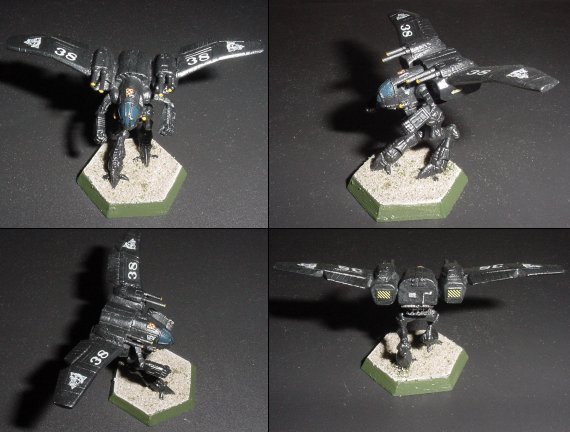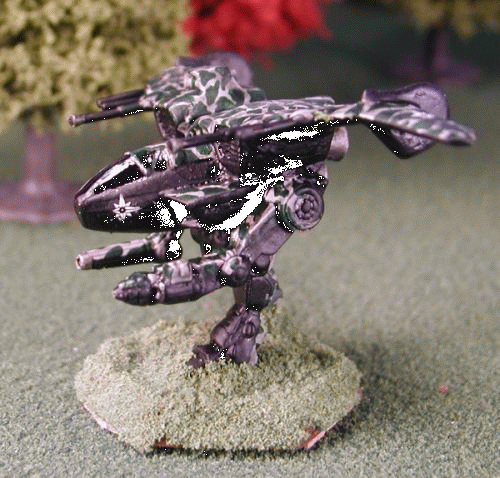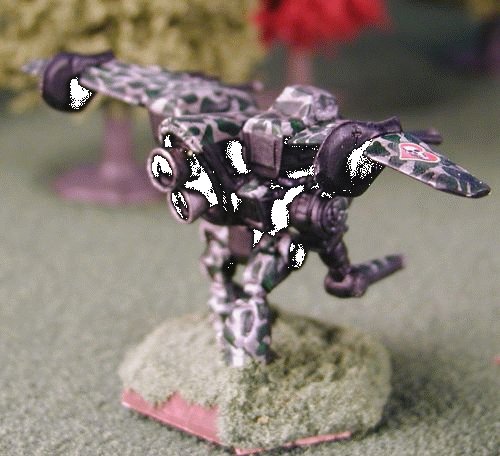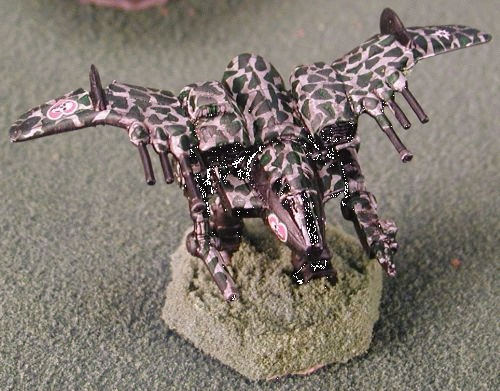of the Irish Dragoons
   
|
 |
   
|
 
|
The Nazgul Mk. XIV |
Although the Nazgul proved to be an effective design for a LAM, Irish Dragoon engineers felt there were areas for improvement. So they teamed up with designers at Novelty Iron Works. The people at N.I.W. were just coming off the very successful Narwhale design program and were anxious to take on another project. Original Nazgul design by Jason Crowe
 One of the first issues to be addressed was the revamping of the aerodynamic properties of the original Nazgul. The fuselage was elongated and streamlined for better in-flight handling characteristics. Also the external gun pods were eliminated in favor of the more traditional design with the weapons embedded in the wing itself. The original long legs of the Nazgul resulted in a high center of gravity. For better ground handling and stability the legs were shortened. Additional myomer was added to make the transition into flight mode easier. Armor was also increased on the legs to protect this vulnerable part of the LAM. Armament was beefed up as well. The streamlining efforts mandated the removal of the nose guns so a medium laser was added to the arm. A Streak 4 SRM was mounted on top of the nacelle for close engagements. Louvers were installed over the front of the launcher to improve streamlining. This also kept debris out of the launch tubes. The louvers snap open prior to missile launch. It was admittedly a return to dorsal mounted weapons, but it still represented a net, aerodynamic gain over the original gun pods. The wing structure was maintained mostly intact with the exception of embedding the main weaponry in the wing root. One problem that plagued the original Nazgul however, was poor lateral control when airborne. The improved streamlining of the new design greatly exacerbated the problem. As a result rudder fins were added to the ventral side of the wings at their midpoint. This small addition rectified the last of the instability issues. Finally, two issues that had plagued all LAM designs were addressed. The first issue was storage on a DropShip. Because of the wings, a LAM could take up as much as double the space normally used by a BattleMech of its class. This often resulted in a LAM being disassembled for transit and reassembled at the destination; a very time consuming process. The designers easily remedied this problem by adopting the idea of folding wings. Since the wings were set high up on the fuselage and well towards the back of the LAM, it was an easy matter hinge the wings just outside the rudders and have them drop down for storage and transport. The second issue was damage to the wings during combat. Even the most ardent LAM pilot would curse the machine and all its designers once one or both wings became damaged to badly for the ‘Mech to fly. Ground handling abilities were often severely impaired and many times the LAM became a sitting duck for enemy machines. The designers at Novelty Iron Works again came up with a simple but very effective solution. They added explosive bolts to the wing main spars. If either wing became damaged the pilot could jettison both wings and function like a regular ‘Mech. Originally the bolts were added to the folding hinge structure, but this proved to make the structure unnecessarily complex. It also weakened the over all strength of the hinge. The next suggestion was at the wing root, but that approach stripped the Nazgul of the majority of its weapons suite. The designers settled on a location between the wing root lasers and the rudders. This configuration proved ideal. Once the bolts were blown the majority of the wing structure was discarded and yet the ‘Mech retained all of its weapons and its lethal capability. When the new design was “rolled out” of the hanger for the first time; it bore only a moderate resemblance to the original progenitor. There was some discussion of coming up with a completely new name for the design, such as the Uruk-hai. This talk was short lived however. All those who were involved in the work on the new LAM agreed that the project owed much of its success to the ground breaking advances made by the designers of the first Nazul. They also agreed that the LAM was to far removed from the original for it to carry the simple designation of Nazgul 2. So to honor its heritage and yet denote its extensive evolution, they dubbed the revolutionary and exciting new design the Nazgul Mk XIV. 

 |